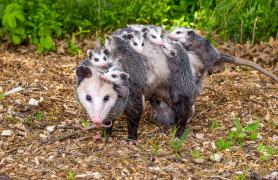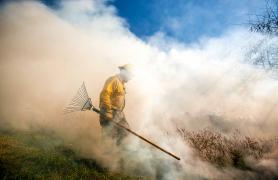Kyle Hedges had pulled the trigger on many fastflying bobwhites in his lifetime, but this quest for quail was different.
He had neither a shotgun nor bird dog as he made his way through the shrubs and open areas of the Bois D’Arc Conservation Area (CA) in Greene County. Also contrary to normal hunting routine, Hedges needed the bobwhites he was searching for to stay put, not flush. This was so the radio telemetry gear the MDC wildlife management biologist was toting this early September day could make solid connections with transmitters attached to quail he hoped were nesting in the surrounding briars and bramble. The electronic “beeps” coming from Hedges’ transmitter offered encouraging information about the hatching of a new generation of bobwhites at Bois D’Arc CA and the birth of new quail management strategies for all of Missouri.
Hedges and fellow MDC Wildlife Management Biologist Frank Loncarich are the lead researchers on an MDC research project focused on quail nesting, brood rearing, and habitat selection. The data coming out of this five-year study, which concluded in September 2018, is bringing several alterations to the fabric of quail management in Missouri.
“We’re not suggesting the quail management done in previous decades was wrong,” Hedges said. “It very likely worked for what we had back then when we had a lot of small farms and a lot of land broken up into small fields and small pastures. But the landscape has changed and what this study seems to be suggesting is that nowadays, there might be a better way of doing things.”
At the heart of this research project is a bird Missourians love to love — the northern bobwhite quail (Colinus virgianus). The eastern bluebird may be the state bird but Show-Me Staters who have any type of link to rural Missouri also have strong feelings for this plump brownish creature adorned with attractive flecks of white and black.
“Across Missouri and throughout the Midwest, many people have some type of historical association with quail,” Hedges said. “Either they hunted them, or their parents or grandparents hunted them. Today, some landowners looking for habitat advice tell us they don’t even want to hunt them. They just want quail on their property, so they can hear them whistle each spring. That familiar bobwhite call brings back all those memories of the quail’s good old days.”
Learning from the Past
Bringing back the good old days of quail may require changing some of the good old ways of management. That’s what the results of Hedges’ and Loncarich’s project are indicating. The study compared how quail did in food plot areas — the traditional model of bobwhite management — with how they did in grassland areas, a newer strategy.
“This study was not a result of something we only saw as area managers, but as hunters, too,” Loncarich said. “We were seeing more quail on grassland areas we managed and also where we hunted. When we started seeing that, we started asking questions.”
Hedges and Loncarich have traveled a long and scientific road to find the answers to those questions. Their research project involved more than 1,300 radio-collared quail and more than 500 nests monitored across 14,000 acres of public land. At each study site, the work began with the radio-collaring of 60 male and female quail. (Males do a portion of the egg-sitting duties, so it was important to collar both sexes.) Once a nest was located and identified as an incubating site, it was monitored three to five times per week until the estimated hatch date. Then the brood was periodically monitored. Throughout this process, habitat preferences were noted to see what kind of habitat treatment was being selected.
Study Results
And what did the study show?
- Grassland sites had a 12% higher nesting success than traditional food plot sites.
- Adult survival was also better on grassland sites than food plot sites.
- In large grassland sites, both adults and chicks preferred areas that had been burned or grazed by cattle in the last 12 months. This indicates quail and their broods may have a much higher preference for this type of land than was previously believed.
- Conversely, if a grassland area had not been burned or grazed in the past 12 months, quail broods spend minimal time there. Idle grass appears to be too thick for quail to use throughout much of the breeding season.
The study also revealed new knowledge about nesting. The peak of Missouri’s quail hatch was thought to be mid-June but in the monitored nests, the first nesting peak occurred the last week of June and nearly as many nests were hatched in July and August. More than 50% of all nests monitored didn’t start incubation until after July 1. Some of these were renesting efforts, but many were first-of-the-year nests.
It’s hoped the findings of this research project — the largest radio telemetry study of quail ever done in Missouri — will help a bird that has struggled in recent decades in Missouri and elsewhere across the Midwest. Long-time wing shooters remember the halcyon days of Missouri quail hunting 50 years ago when the state’s annual harvest topped 3 million birds. These days, statewide surveys indicate less quail abundance and greater habitat challenges. Today, Missouri’s landscape has a higher prevalence of fescue and other nonnative grasses that are less friendly to quail. Farming practices have also changed. Today’s fields provide quail with fewer overgrown field corners, weedy fencerows, and less grain left in fields. Add these factors to the age-old challenges of nest predation and unfavorable weather and it creates a landscape that has many more challenges for quail than it did a half-century ago.
Ironically, one factor that doesn’t have as big of an impact on the sustainability of quail populations as some might think is hunting pressure. Studies have shown the majority of quail live less than one year whether they’re hunted or not.
Two of the primary keys to bobwhite abundance is nesting and brood-rearing success, two processes that are completed before Missouri’s Nov. 1–Jan. 15 quail hunting season occurs. If a quail can hatch its eggs (a process that takes about 23 days) and successfully rear its brood (a three-week process) in its first year of life and, the next year, those offspring have successful broods of their own in their year of existence, an exponential cycle of growth is created.
Thus, an important tool in keeping quail thriving on Missouri’s landscape is to gain a better understanding of nesting and brood-rearing habits and habitat. Improving the future of quail in Missouri lies squarely on the findings of Hedges’ and Loncarich’s project.
Missourians Care About Quail
“Ultimately, the goal of this study is to determine how to best manage for quail in today’s landscape,” Loncarich said. “Actually, this goes back to the fundamentals of quail management, which is to maximize usable space. That’s what we’re doing. We’re trying to maximize the usable space for quail on our management areas.”
In 2018 alone, MDC implemented management practices on approximately 69,100 acres of public lands to benefit quail. MDC staff provided technical assistance and/or funding for an additional 77,800 acres of private land. Having nearly 150,000 acres of habitat management occurring each year specifically for quail is an indication of what many state residents already know — Missourians care about quail.
“The preliminary results of this study, combined with those from other studies conducted around the country, are causing us to pause and reevaluate the way we approach habitat management on public lands, as well as our advice to private landowners interested in quail management,” said MDC Small Game Coordinator Dave Hoover.
Hedges and Loncarich plan to present their findings to other biologists in Missouri and other states, but their goals for the data go beyond Power Point presentations to their peers.
“We hope to use this information to guide future quail management in Missouri,” Hedges said. “We hope we can improve quail populations on some of our public areas and, where the landscape is favorable and landowners are interested, we can hopefully improve the population across both public and private lands.”
“Although there is more work to be done, this should excite all Missourians that care about quail and the many other species that stand to benefit,” Hoover said. “We are very focused on making a difference at the landscape scale.”
“This is a quail research project — that’s true — but it is much more,” Loncarich said. “This project has the ability to fundamentally change how we manage for quail in Missouri going forward.”
Life of a Bobwhite
- Most quail live less than one year, whether they are hunted or not
- Courting pairs form April–May
- Hens lay first nest of 10–20 eggs and incubate for 23 days
- Either male or female will stay with brood for three weeks
- Chicks hatch fully-feathered and mobile
- Flight abilities develop at 2–6 weeks old
- Hatching begins in June and continues throughout the summer
- Juveniles nearly size of adults by 12–16 weeks old
- Coveys of 10–20 form in October and stay together through winter
- Coveys roost shoulder to shoulder to keep warm




















Also In This Issue


And More...
This Issue's Staff
Associate Editor - Larry Archer
Staff Writer - Bonnie Chasteen
Staff Writer - Heather Feeler
Staff Writer - Kristie Hilgedick
Staff Writer - Joe Jerek
Creative Director - Stephanie Thurber
Art Director - Cliff White
Designer - Les Fortenberry
Designer - Marci Porter
Photographer - Noppadol Paothong
Photographer - David Stonner
Circulation - Laura Scheuler






















